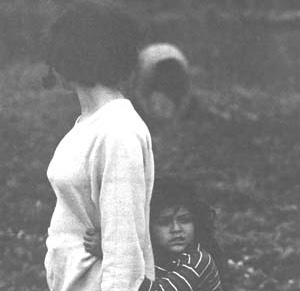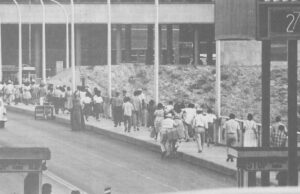OAKLAND, Calif.-The talk over Mexican food in the Fruitvale barrio here is pessimistic, almost wistful for the turbulent ’60s. Tony Valladolid, a young lawyer at Centro Legal de La Raza is reminiscing about those days: “The San Diego State administration building had burned down and we had about three or four good riots. But now that the (minority) programs are being cut back the Chicanos don’t know what to do. They no longer have the political awareness. They try to go through channels and it is ineffective.”
 The gist of the lunchtime conversation among the Centro Legal staff-including Ed Roybal Jr., the son of the congressman-is that life is not getting easier, but tougher, for Latinos. The lawyers have been trying with little success to get the Justice Department to investigate the case of Jose Barlow Benavides, killed in 1976 by a policeman who put a shotgun to his head as he frisked him. They say that the climate between the police and Latinos is not good and part of the problem is that Oakland recruits many officers in southern states where there is no understanding or sympathy for Latinos. Of 1,800 police personnel in Oakland, only 12 are Latinos. But Centro Legal has stopped encouraging Hispanics to join the force; it has discovered that some of the most brutal cops are Chicanos. “If you are going to make it in the Police Department you have to come down hardest on your own people,” explains one of the lawyers. He adds that police violence is incredibly high.
The gist of the lunchtime conversation among the Centro Legal staff-including Ed Roybal Jr., the son of the congressman-is that life is not getting easier, but tougher, for Latinos. The lawyers have been trying with little success to get the Justice Department to investigate the case of Jose Barlow Benavides, killed in 1976 by a policeman who put a shotgun to his head as he frisked him. They say that the climate between the police and Latinos is not good and part of the problem is that Oakland recruits many officers in southern states where there is no understanding or sympathy for Latinos. Of 1,800 police personnel in Oakland, only 12 are Latinos. But Centro Legal has stopped encouraging Hispanics to join the force; it has discovered that some of the most brutal cops are Chicanos. “If you are going to make it in the Police Department you have to come down hardest on your own people,” explains one of the lawyers. He adds that police violence is incredibly high.
The talk among the four Centro Legal staffers-Tony, Ed, Linda Castro and George Singh-turns to education. One says that Chicano university enrollment is declining to pre-1964 levels. Tony says that the climate, which led to the unrest of the ‘60s, is returning. “The majority of Chicanos entering law schools now are not too keen on helping their own people but still consider themselves Chicanos,” he laments.
Such gloom is not peculiar to Oakland but can be found throughout the nation. Latinos from New York to Chicago to Denver to San Antonio and the West Coast are beginning to see many of their gains of the past decade taken away. At the same time, they sense increasing resistance to their goal of achieving economic, educational and social parity with white America. Here are some of the things that trouble them:
Latinos in higher education are encountering more and more difficulty in gaining tenure or promotion. Bilingual education is under attack and the Carter administration’s support is weakening. The Senate committee hearings on the Carter immigration bill, so crucial in making millions of Latino undocumented immigrants less vulnerable to inhuman exploitation, have been postponed indefinitely by the Senate after first being scheduled for March. The widely publicized Bakke case, it turns out, is only a skirmish in a general assault on affirmative action. The bill to establish a national office of Hispanic affairs is stalled in the Senate Committee on Governmental Affairs, and the National Council of La Raza warns it may die there. Also, a Los Angeles federal judge has declared unconstitutional a provision of the 1977 Public Works Act that requires a 10 percent of the work to be done by minority-owned businesses.
Such bad news creates feelings of betrayal among Latinos. They are beginning to see that the advances of the past decade were not a breakthrough into the mainstream but mainly a trickle, which is being sealed off. Yet, in those days when the street warriors of the Movimiento-as the militancy was labeled-were preaching many establishment barriers, hopes were high. And indeed, the response of the nation justified the visions, which the Latinos are now beginning to perceive as mirages.
For the first time, Hispanics began appearing on the campus in large numbers, brought by aggressive recruiting and kept there with tutorial programs and grants seeking to overcome the disadvantages of poor barrio schools and poverty. At the University of California, for example, they increased from 58 in 1967 to 580 a few years later. Equal employment opportunity legislation raised hopes that discrimination would soon end on the job. U.S. Civil Rights Commission exposure of inequities in the administration of justice and of inadequacies in the educational system built expectations that reform would soon follow.
The enactment of bilingual education laws promised Latinos that their children would soon be able to be full heirs of America’s educational opportunities. The appearance of token Latinos in government and industry conjured visions of many more within a short time. The success of a few nurtured the impression that the Hispanics as a people would soon be achieving the high standard of living of the white majority.
It was not to be! With the special minority programs now being cut back at universities, the Latinos are having troubles. Centro Legal de La Raza in Oakland says that the environmental difference is so great between the barrio and the campus that the Latinos often can’t take the culture shock.
On the job front, the Equal Employment Opportunity Commission finds itself mired in a backlog of 100,000 cases. Municipalities, state and federal governments and school systems employ Hispanos only in token numbers. Especially in education, Latinos who have achieved high plateaus seem to be under attack. In Denver, Dr. Jose Perea is suing after being removed from his position as vice president and chief executive at the Auraria campus of Community College of Denver. At the University of California at Santa Barbara, Dr. Jesus Chavarria is fighting for his academic life after the History Department refused him tenure. Dr. Sylvia Gonzales is undergoing the same sad experience at San Jose State.
Police violence against Hispanics is high. Gil Pompa, head of the Justice Department’s Community Relations Service reports that Latinos are the victims in 44 percent of the police misconduct complaints received by the Justice Department. Four years ago, Latinos were involved in only 24 percent of such complaints. There is no major city in the nation with a sizable Latino population, which has not had its questionable police killings, although Texas seems to be the worst offender. The only bright note in this bleak picture is that some of the killers are being brought to trial, although convictions have not resulted in long prison sentences.
Bilingual education is hardly meeting the challenge. State Representative Ruben Valdez of Colorado testified last year before the congressional Subcommittee on Elementary, Secondary and Vocational Education to the effect that there are at least 1.9 million students whose usual language is not English, and 48 percent of them have language difficulties. But bilingual education is reaching only 13 percent.
The employment of Latinos in public or private sectors has not improved significantly, and the federal government, which should be leading the way, is making only small progress. Back in 1969, the Civil Rights Commission reported that only 2.8 percent of more than 2.6 million federal civilian employees were Spanish-surnamed, and these were concentrated in the lower grade levels and in blue collar jobs. Despite the launching of the Sixteen Point Program in 1970 to correct that inequity, Latinos on the federal payroll had not increased by even one percentage point by 1976. At that same time, they were 3.3 percent of the workforce and 60 percent of them were in blue-collar jobs. Only .6 percent were in levels of GS-16 or above. At the rate that Latinos have been trickling into the federal government, they will not reach parity until the year 2025. And despite the fact that 81 percent of the Latinos voted for Jimmy Carter, the present administration has been moving slowly in fulfilling its promises to appoint three times as many Hispanics to government positions as were named by the previous administration.
I he situation is worse in major cities. In Chicago, for example, Latinos comprise between seven and 25 percent of that city’s population: as many as 870,000. But in 1977 they held only one of every hundred city jobs and only one of every 1,000 positions of Corporate responsibility, according to a report by Northwestern University’s Center for Urban Affairs.
Politically, the Latinos remain almost completely without a voice. Rapidly approaching 10 percent of the nation’s population, they have less than one percent of the seats in Congress: a mere five Representatives. In the nation’s largest cities, with few exceptions, they are almost totally disenfranchised. The estimated one million Latinos in the Chicago metropolitan area have no representation in Congress, in the state legislature or on the city council. Los Angeles County’s 1.5 million Latinos have no representation on the city council or county board of supervisors. California, with an Hispanic population approaching four million, has only four Hispanic assemblymen and two senators in the state legislature, one fewer than Colorado (which has only a few hundred thousand Latinos).
School desegregation is also being contested every inch of the way. In Los Angeles, where Latinos are now the largest ethnic group with 35 percent of the total enrollment, the school board has yet to develop an effective integration plan. The U.S. Commission on Civil Rights found a “record of dilatory conduct, resistance to its constitutional duty and apparent bad faith” on the part of the school board.
The overall lack of economic progress by Latinos and other minorities was emphasized by the Civil Rights Commission i1i its report on the state of civil rights in 11,977. It said that the disparities between whites and minority groups did not diminish despite an overall decline in joblessness and a rise in income. 1977, the average Latino family earned only $10,259 annually while the age white family made $15,176, the Census Board reported recently. Puerto ns were the most deprived, averaging YL $7,669 per family. Mexican Americans came next, with a family income of $10,322, and Cubans led with $11,775. A shocking 38.8 percent of all Puerto Rican families had incomes below 5,500-the poverty demarcation- followed by Mexican Americans with 22 percent, Cubans with 16.9 percent and Central and South Americas with 13.4 percent. Only 8.7 percent of white families were in the same predicament. In sum, a clear-eyed assessment leaves the Latinos with no pretext for fiesta. The road ahead is all uphill and the journey is imperiled by the hardening attitudes of the white majority to the aspirations of minorities. Nowhere is the challenge more difficult than in education. The Justice Department’s Community Relations Service reported last year that, while the educational disparity between whites and blacks was either closing or, at least stabilizing, the gap between Anglos and Hispanos was widening. This trend is so worrisome nationally that the U.S. Office of Education has been authorized by the Department of Health, Education and Welfare to cosponsor (with the National Council of La Raza) a national symposium early this summer to seek answers to that perplexing problem. Latinos find themselves behind both whites and blacks in educational achievement.
A concept paper presented by Gil Chavez, director of the Spanish-speaking Program Staff of the Office of Education, in a recent Washington planning session for the symposium says: “The educational status of the Hispanic population of the U.S. is deplorable and, far from perceiving progress, the available indices point to a deteriorating situation that must be reversed.” The paper cites a recently completed study by the Education Commission of the States, which concluded that Hispanic students are “consistently below their contemporaries in the rest of the nation in reading, science, mathematics, social studies and career development.”
The irony is that the decline is occurring even as Latinos log more years of education. “Today,” said Dr. Rudy Acuna, a professor at California State University at Northridge, “Chicanos have completed more years in school but fewer can read.” He cites statistics from a predominantly Chicano high school on the West Coast showing that even those students who graduate at the top of their class are below average on a national scale. The same complaint has been voiced by Catholic Bishop Patricio Flores of San Antonio in demanding better quality education in the barrios.
In the face of all these difficulties, warnings are being sounded in many quarters that the street battles of the 1960s may have to be fought all over again. La Onda, the Chicano newspaper at Stanford University, stated recently: “The political atmosphere in this country continues to point toward an era which may go down in history as the ‘turbulent 80s.”‘ Such talk might be easy to dismiss if Chicano students were the only ones voicing it. But no less a national figure than Secretary of Labor Ray Marshall has been expressing similar fears. In a talk to the American and Citizen Committee in New York last year, he said:
“I believe that the existence of an underclass of undocumented workers represents a serious civil liberties problem. No democracy can flourish with an underclass outside of its basic laws. If history is any guide, perhaps the first generation of undocumented workers will endure their privations in relative silence. But you can rest assured that the children of these undocumented workers will be the focus of a civil rights movement of the 1980s.”
This article may be published with credit to Mr. Sandoval as a Fellow of the Alicia Patterson Foundation and to Maryknoll Magazine.
©1978 Moises Sandoval
Moises Sandoval is spending his fellowship year writing about “The Latinization of the U.S.”


